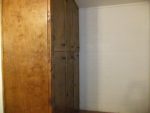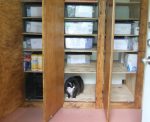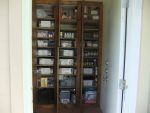No doubt, we all have a medicine cabinet of some size. Lately, I reorganized and consolidated our medical
supplies with the major assistance of my kind talented husband who built a set of floor-to-ceiling cabinets dedicated to that purpose even though he dislikes doing carpentry. (Thank you!) Because I am a retired and disabled physician, I obtain supplies to mainly care for those under our roof in a TEOTWAWKI situation.
Of course, we all are very aware of recent supply shortages (masks, hand sanitizer, medications-both over the counter and prescription) but what about the possibility of a decline in the level of care offered? I am referring first to those in less fortunate countries where you either bring your own supplies, do without, or risk contamination. Does anyone remember the U.S. ice pair dancer who fell and sustained a serious skull fracture with permanent hearing loss in Russia several years ago? I recall the compassionate and prompt action of a Ukrainian-born skater who rushed to the hospital with his own personal stash of supplies including clean sheets, bandages, syringes, needles, etc for her to use. Will the day come, when we need to consider having a selection of medical supplies for our use at a U.S. hospital or clinic?
I am aware that some people already order casting supplies for treatment of their fractures in order to avoid elevated prices at medical care facilities. We’ve all heard horror stories of outrageous fees for simple bandages or an aspirin at emergency rooms. Who knows what the future will bring? Maybe it is time to re-evaluate what we have on hand and consider situations where we may be fortunate enough to have access to a health care provider, but he/she may be without supplies.
Disclaimers: I am neither prescribing nor advising medical treatment for anyone. Any actions or decisions you make are at your own risk. By the way, I neither work for nor receive funding from any of the companies whose products are listed below. Many items are readily available on eBay, Amazon, Walmart, Sam’s Club, or other online stores. Just shop around for availability and pricing, which of course change rapidly in times of high inflation.
My New Cabinet
Together, we decided to locate a floor-to-ceiling wood cabinet with closing doors in an unused but easily accessible corner. Prior to construction, careful consideration was given to the size and
number of bays desired. Certain taller equipment would need to be located in 17 inch tall bottom compartments and again in the uppermost shelf. It was determined that most supplies would be stored in inexpensive clear 15-quart plastic latching totes. These measure 16.25 by 11 by 6.83 inches each.
The cabinet was constructed mainly out of plywood. 3/4 inch plywood was utilized for sturdy supports on the major closed ends and also for the doors. Facings were made from 2x4s.
 1/2 inch plywood was the material for shelving which were supported on L brackets. At the back, the L brackets were screwed into the wall studs. All of which makes possible a cabinet of 24 inches deep using 4′ x 8′ plywood, material for economy. The visible side of the cabinet was made of attractive birch. The upper supports were attached to the ceiling joists. Finally, the exterior was stained, sanded, and finished with six door pulls attached at convenient heights. See the first photo which shows the finished exterior of the unit.
1/2 inch plywood was the material for shelving which were supported on L brackets. At the back, the L brackets were screwed into the wall studs. All of which makes possible a cabinet of 24 inches deep using 4′ x 8′ plywood, material for economy. The visible side of the cabinet was made of attractive birch. The upper supports were attached to the ceiling joists. Finally, the exterior was stained, sanded, and finished with six door pulls attached at convenient heights. See the first photo which shows the finished exterior of the unit.
Due to the size of the totes, it was planned to build each of the three horizontal bays 17 inches wide at the opening and 24 inches deep so as to accommodate two totes sideways front to back and most shelving only 8 inches tall. Three lower doors and three upper were constructed for ease of opening and with less swing space required than if there were only two doors. Extra tall space was again planned for larger lightweight infrequently used storage boxes on the top shelf. In order to reduce the need to remove and unstack totes, containers would not be placed on top of each other and only less frequently used supplies would be stored behind the first box. Given that I am short and not strong, most important items would be stored within my easy grasp and at the front.
 Supplies aren’t much use if you can’t find them. For easy reference, I created large, bold, typed identification labels and lists for the face of each container. A matching “map” and a typed master list is attached to the door so that all individuals will be able to quickly find any needed item. Sometimes the doc is the victim of illness or accident and needs assistance too! Everyone will also receive a proper orientation and emergency drill. I have included a couple of photos showing the interior in the process of organization and the different sizes of shelving. A few not-yet-filled bays are still visible—but not for long. In a large lower bay, a portable “cat scan” was temporarily located until she decided to go lounge elsewhere in the sun.
Supplies aren’t much use if you can’t find them. For easy reference, I created large, bold, typed identification labels and lists for the face of each container. A matching “map” and a typed master list is attached to the door so that all individuals will be able to quickly find any needed item. Sometimes the doc is the victim of illness or accident and needs assistance too! Everyone will also receive a proper orientation and emergency drill. I have included a couple of photos showing the interior in the process of organization and the different sizes of shelving. A few not-yet-filled bays are still visible—but not for long. In a large lower bay, a portable “cat scan” was temporarily located until she decided to go lounge elsewhere in the sun.
Contents of the Lowest Bays
 The left lowest bay is perhaps the most important. In the back is a shoulder style bag containing iv fluids plus supplies for iv administration (gloves, needles, tubing, wipes, velcro tourniquet, tegederm, tape, …) and also other materials for the treatment of dehydration syndrome (powder mix for oral rehydration, anti-diarrheal agents, …). In the front, is a travel bag with *numerous* compartments and clear plastic bags for other emergency care. The lightweight bag is not only very economical, but can be either carried by handle or rolled with an extendable grip. This is helpful for the aging doc. The “red tag” compartment contains pulse oximeter, airways, CPR shield, mylar blanket, headlamp, pen light, a pair of gloves, thermometer, and a few medications. The next pouch contains more nitrile gloves, scalpels, prep pads, ink pen, Velcro pouch with instruments.
The left lowest bay is perhaps the most important. In the back is a shoulder style bag containing iv fluids plus supplies for iv administration (gloves, needles, tubing, wipes, velcro tourniquet, tegederm, tape, …) and also other materials for the treatment of dehydration syndrome (powder mix for oral rehydration, anti-diarrheal agents, …). In the front, is a travel bag with *numerous* compartments and clear plastic bags for other emergency care. The lightweight bag is not only very economical, but can be either carried by handle or rolled with an extendable grip. This is helpful for the aging doc. The “red tag” compartment contains pulse oximeter, airways, CPR shield, mylar blanket, headlamp, pen light, a pair of gloves, thermometer, and a few medications. The next pouch contains more nitrile gloves, scalpels, prep pads, ink pen, Velcro pouch with instruments.
Two other sections include clotting agents, Israeli bandages, tourniquets, chest seals, ADS needle for tension pneumothorax, BP cuff, stethoscope, masks, gauzes, tapes, etc. Nearby are goggles, sterile gloves, sterile drapes, irrigation syringe, steristrips, bandages, betadine, soap, triple antibiotic cream, etc. Last squeezed in are instant cold packs, ace wraps, SAM splint, and burn gel. This list is not all inclusive nor meant to be advice. (BTW two IFAK totes are located higher up in the cabinet containing what is typically recommended for such.)
Next on the shelf to the right is the pharmaceuticals box plus a large elongated tub containing bottles of alcohol, betadine, peroxide, pool shock, and Chlorox. (All of these are tape-sealed and heavily wrapped to prevent corrosion of metal). Next is a large metal basin, bedpans, an oxygen concentrator, and in the back are a nebulizer and other oxygen tubing and sodium chloride ampules.
The next row of bays from left to right are boxed gloves (lots of medical gloves both sterile and not plus some heavy duty kitchen type), more cleansing solutions and sprayers, and then a dental box and GYN/GU box. The dental box contains topical anesthetic gel, bite blocks (erasers plus moldable blocks for TMJ), temporary cement kits, more zinc oxide and eugenol, cotton balls and pellets, instruments for cleaning/removing decay/filling and carving cement/tooth extraction, and curved tip syringes. Toothbrushes and floss are stored separately. May Jesus in his mercy provide us a qualified dentist when needed – but if not, we have the useful guide book Where There Is No Dentist, which should be a standard text in every prepared family library.
Sterile lidocaine powder and the means to rehydrate it for sterile injection is also packed away as lidocaine vials have a short shelf life. The GYN/GU box includes supplies for emergency childbirth, water-soluble lubricants both regular and sterile, and urinary drainage bags. Catheters are in a separate longer storage container. The next level up has a tub of alcohol wipes/needles/syringes with additional boxes of needles. To the right is a “head and patient care” tub with ear wax removal loops, eye foreign body remover, moldable nose fracture splint, lice combs, magnifying lenses, digital mini scale, several additional pairs of medical scissors, straws (angled metal, plastic bendable), and traditional non-battery operated thermometers (basal, oral, and rectal).
The last bay contains a surgical tote, orthopedics tub, heating pad, lots of ace wraps, and several
instant cold packs plus ice bags. The surgical tote includes, but is not limited to, masks, scalpel handles and blades, surgical staplers, various sutures absorbable and non-absorbable, plus a good-sized set of surgical instruments. The orthopedics tub holds more ace wrap, Coban wrap, instant cold packs, sterile and nonsterile gauze, and splints. Additional old equipment (braces, splints, rigid and soft neck collars, walking boots, slings) are in the upper half of the cupboard. Various sized crutches, a wheelchair, a walker, and a bedside commode are stored elsewhere. Casting supplies of tubular stockinette, cotton padding web roll, and plaster rolls are in the upper half of the cabinet too.
The next level contains four totes of bandages. Yes, you can never have too much such as good old bandaids, moleskin, butterfly/steristrips, sterile gauze (4×4’s, combine pads, conforming, triangle, nonstick, petroleum, s roll, cottontip applicators, and iodoform packing strip), and clean white sheets. The latter can but cut into bandages if needed and cleansed by ironing with a hot iron if we are back to living like the 1800s. Also remember, where there are bandages. You will probably want tape (paper, plastic, adhesive…) Also helpful are wipes (alcohol, BZK, betadine, benzoin) and topical antibiotic cream.
I also store raw honey and Manuka honey. One bay on this level and the next holds rows of supplements such as vitamins, calcium, etc.
The top level of the cupboard’s lower half has two tubs dedicated to IFAK kits and their replacement supplies. There is also an herbal tote containing equipment for the production of herbal tinctures such as several dark glass dropper bottles, pipettes, funnels, sieves, mortar and pestle, garlic press, charcoal activated powder, and food grade diatomaceous earth. Yes, we are growing a medicinal garden too and learning more as time goes by. In front of the herbal box is the airway box with an adjacent ambu bag.
Finally, at my son’s request, there’s a space for some of his preferred treatment items. Those are of a more “do-it-yourself” nature, and include a roll of duct tape, a roll of paper towels, and some super glue. While those supplies aren’t sterile, they can be useful in a pinch.
Contents of the Upper Half
The first two rows of the upper half hold tubs containing extra bottles of everyday over the counter meds and are labeled “Digestive”(such as antacids, acid blockers, simethicone), “Nausea/Vomiting/Diarrhea”, “Skin”(antibacterials, antifungals, burn gel, cortisone creams), “Colds/Allergy/Sleep”, “Ibuprofen”, “Acetaminophen/Aspirin”, and “Naproxen”. Another bay has two totes filled with masks such as ear loop, allergy, N95, N100, and particulate respirators. Other “goodies” (definite sarcasm here) include enema buckets (Oh joy! They are also useful for rectal rehydration), cloth hospital gowns, disposable isolation gowns, and coverall suits. A “vision” box contains eyeglasses, sunglasses (clip on or framed), and cheap readers of all strengths.
While the cabinet’s medicine section is meant for everyone’s use, it isn’t comprehensive. People who have their own unique needs keep personal medicines separate. My son finds the supplies in the large cabinet a bit cumbersome to access, so he keeps his own neatly labeled medicines in plastic containers elsewhere. When replenishing personal use medicines from the common stock, we update inventory and make sure to use the older ones first. Just like food storage – store what you use, use what you store, and rotate your stock.
Conclusion
As always, remember that while I am a physician, I am not your physician. I am not prescribing or recommending anything specifically for you, and I am not intending this article to be all-inclusive. This is merely meant to be food for thought and a useful example. It is my hope that it may be a blessing to some and hopefully an aid in further preparation. Wishing you all the best.
JWR Adds: K.B. has given some outstanding advice that should be heeded. To re-emphasize one of her points, do not overlook stocking up on bulk quantities of mild laxatives, such as powdered Metamucil. This will become crucial for anyone who has their diet shift heavily toward butchered meat, including wild game. Also, stock up heavily on bulk quantities of oral rehydration fluids, such as Pedialyte (or powdered ingredients to make the same), since diarrhea will surely be one of the biggest killers during any major societal collapse situation.










